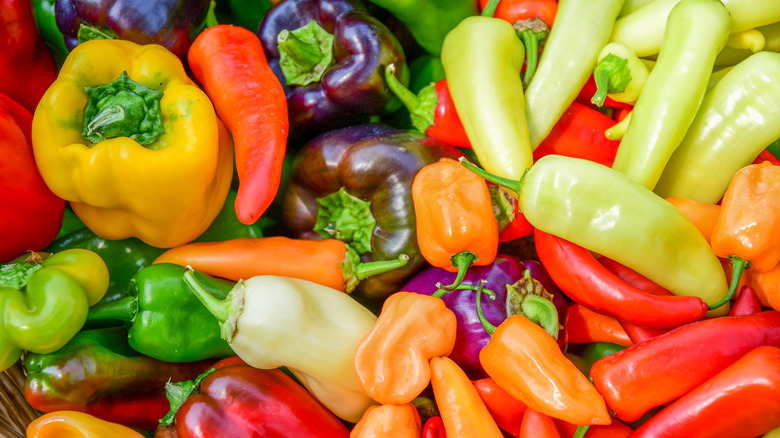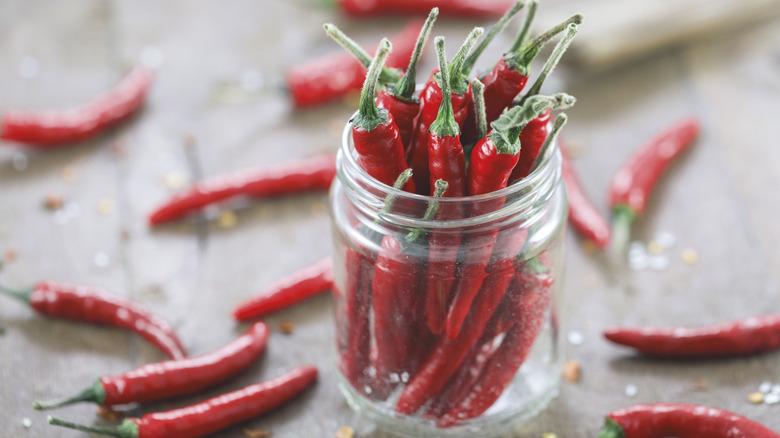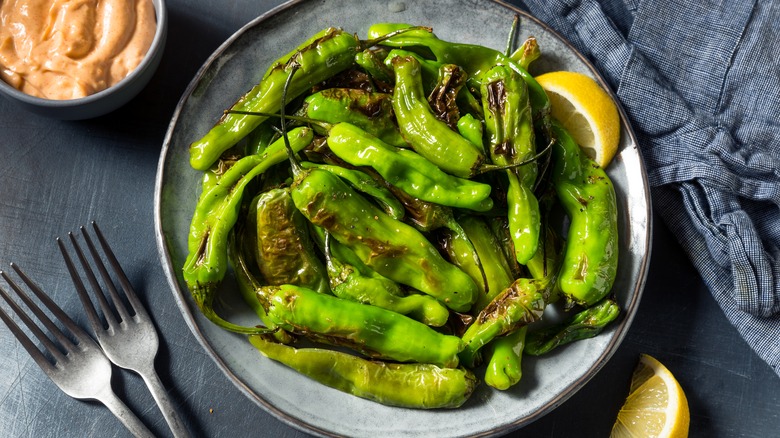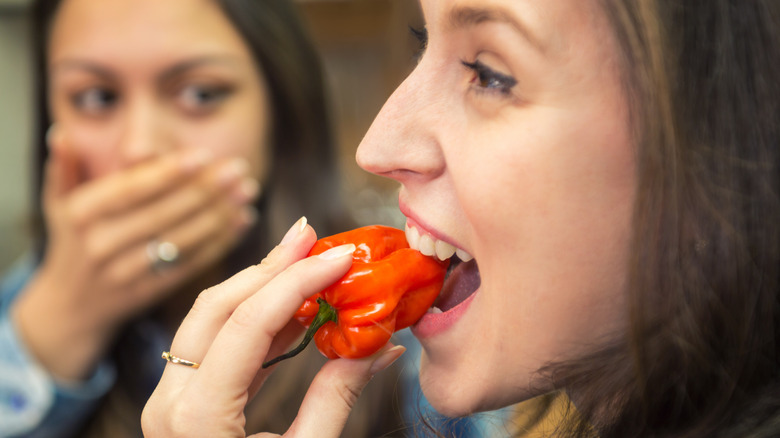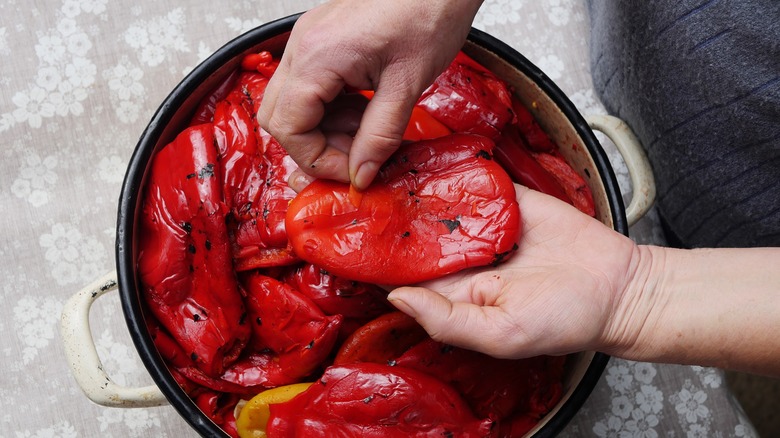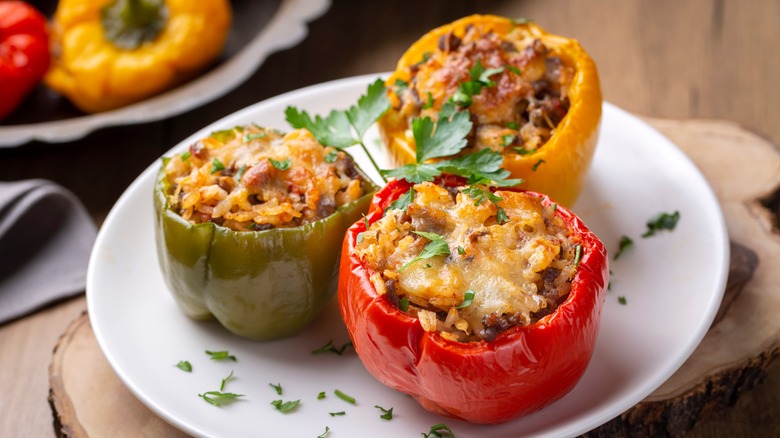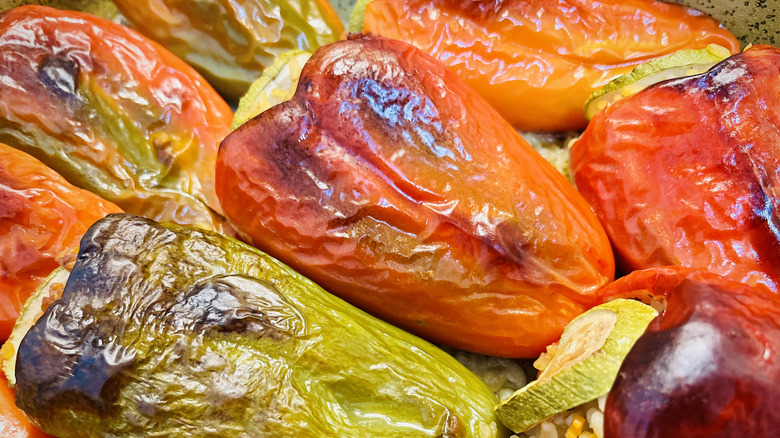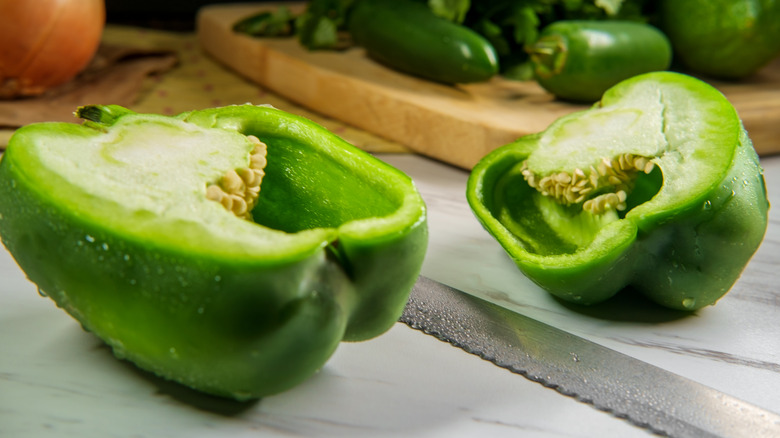Everyone Makes These 7 Mistakes When Cooking Peppers
During my time working in kitchens, I've cooked a wide variety of peppers. Sometimes I roast them en masse for steak fajitas, sometimes I dice jalapenos for a spicy chimichurri, sometimes I ferment habaneros and other hot chili peppers to make hot sauce. For me, peppers are one of the most versatile and exciting ingredients to work with. At the same time, I've made some mistakes along the way that I've learned from.
One of the most interesting things about peppers is how many different types there are. Cherry peppers, scotch bonnets, bell peppers, poblanos, ghost peppers, Carolina reapers — all of these peppers have completely unique shapes, colors, and flavors. Some of them have absolutely no heat whatsoever, and others are so spicy that you might break into a sweat after briefly tasting them. While there are certainly some shared similarities in how to prepare these different peppers, there are also drastic differences between them. Not respecting these differences can get you into trouble. If you want to cook with peppers but you need some tips to help you steer clear of common mistakes, then you're in the right place. These are the most common pepper-related mistakes you can make — and how to avoid them.
1. Forgetting to wear gloves when handling hot chili peppers
If you're cooking with hot chili peppers, one of the biggest mistakes you can make is forgetting to wear gloves. This is because hot chili peppers contain capsaicin, which is a chemical compound that causes a burning sensation. Capsaicin is what triggers that lingering tingle on your tongue when you taste hot sauce and eat other dishes that contain spicy chili peppers. That can be fun, but when you handle hot chili peppers without gloves, trace amounts of capsaicin will inevitably end up on your fingers. If the pepper is spicy enough, that capsaicin can actually burn the skin on your hands. But the problem here often manifests in a worse way, on more sensitive places that your fingers tend to come into contact with. Think eyes, nose, and any other delicate areas of the body that contain sensory nerve endings and mucus membranes.
A common and rather unfortunate mishap usually goes a little something like this: You chop fresh jalapenos for a salsa recipe barehanded, only to be painfully reminded later on when a sudden burning sensation erupts after going to the bathroom. The good news is, you can avoid this entirely by remembering to protect yourself and strap some gloves on before you handle any spicy chili peppers.
2. Buying the wrong type of pepper
These days, many stores have a lot of different types of peppers to choose from. It's common to see everything from poblanos and habaneros to bell peppers and jalapenos. Though they're all in the same loose category, many of these peppers taste drastically different from one another and contain completely different heat levels. Shishito peppers and serrano peppers look quite similar — long, thin, and green — but shishitos are extremely mild and serranos are a little spicier than jalapenos. Fresno peppers, which can be quite spicy, often look almost exactly like mini sweet peppers.
The bottom line: It's easy to use the wrong type of pepper and end up with a dish that tastes way different than you're expecting. Don't just assume that all peppers are seamlessly interchangeable in recipes. Using the wrong type can add too much heat, or perhaps not enough, depending on the dish.
3. Not taste-testing the chili pepper
I'll admit it: There've been times that I haven't followed my own advice. In a rush to make some quick salsa, I've definitely tossed some jalapenos into the mix before giving them a taste test. It's only when I dip my first chip into the bowl of fresh and chunky salsa speckled with bright green flecks that I discover the truth: This batch of jalapeno peppers happens to be exceptionally spicy. As burning waves tingle across my tongue, it becomes crystal clear that I should've taste-tested the peppers before deciding how many to include.
To be honest, most of the time, an extra fiery batch of salsa isn't much of a problem for me. I'm a bit of a chilihead, so it's actually something that I enjoy. It's when I'm cooking for others (who most likely have a lower heat tolerance) that I try to be more conscious of spice levels. The last thing you want to do is cook food for others that's so spicy, people go into a panic. This gets a little tricky, because the same pepper can have surprisingly different levels of heat between batches. One bag of jalapenos can be relatively tame, but the next batch you buy from the store might be way spicier. For this reason, if you're cooking with chili peppers, the best way to gauge spiciness is by tasting them yourself. This will prevent you from accidentally making a meal that's outrageously spicy.
4. Not peeling after roasting
I love roasting peppers. It's easy to do, relatively quick, and absolutely delicious. Roasted peppers also happen to be extremely versatile. Whether they're being used on pasta, nachos, sandwiches, or pizza, they bring a tasty dash of smoky sweetness to everything they touch. That said, if you want silky smooth red peppers that are truly restaurant-worthy, it's important to give them a peel. When peppers are roasted, the skin on the surface chars and blisters, puffing up into waxy bubbles. Peeling off the pepper's skin will reveal the tender fruit underneath. The delicate texture of peeled roasted peppers makes them perfect for salads, soups, and tomato sauces.
Because the skin on bell peppers tends to be thin, peeling them isn't always totally necessary. In fact, when you want to ensure that your peppers still have some structure (say, in an iconic Philly cheesesteak), keeping them unpeeled is the way to go. At the same time, the skin on other peppers like poblanos should definitely be peeled if the pepper has been roasted. This skin is often thicker, so it has a rougher, waxier texture that's not exactly appetizing.
5. Stuffing peppers too much
Put a plate of stuffed peppers in front of me and I'm a happy camper. Perhaps no other dish showcases the almighty pepper better. It's truly the star of the show, literally holding everything together through the natural strength of its bowl-like shape. The stuffing can also be easily customized. Some stuffed peppers spotlight protein-heavy fillings such as beef, pork, and chicken. But they can also be lighter with fillings that feature a healthy mix of veggies and grains. No matter what filling you use, though, it's important to be mindful of how much stuffing you pack into each pepper.
Fillings that feature cheese and other ingredients can melt and expand, spilling out over the top of the pepper and potentially bursting through its walls. Is it the end of the world if some of your stuffed peppers bust open during baking? Of course not. But let's not pretend that it's a desirable outcome. At the end of the day, we all want to make food that we're proud of. Beyond being unsightly, a leaking pepper can also burn a bunch of its filling, making it difficult to eat. To make sure that your peppers don't overflow and burn, leave a little extra room inside for the filling to stretch out.
6. Cooking stuffed peppers too long
This one may seem a bit obvious, but stuffed peppers are pretty easy to overcook. All it takes is a few too many minutes in the oven, and whoops — they've been reduced to mush. Ideally, what we're aiming for is a very specific level of doneness within the peppers. We don't want the peppers too mushy, because then they'll lose their structural integrity and end up looking more like popped balloons on a plate than an appetizing meal. At the same time, we do want the peppers to be cooked through.
The general rule of thumb I live by here is that the pepper should be soft to the touch and only slightly wrinkled. Most of the time, stuffed peppers only need to be covered and baked for about 35 minutes before being uncovered and baked for another 10 minutes or so. After pulling them from the oven, I let them rest on the stove for a few minutes; the residual steam from the pan is typically enough to finish cooking the peppers to perfection. As long as you set a timer and keep an eye on the oven, you should be able to easily sidestep overcooking issues.
7. Not removing the pith
When you cut open most peppers, you'll see a cluster of seeds attached to a pale structure. The spongy white skin inside of the pepper is commonly referred to as the pith. At best, the pith is bland, but at worst, it's bitter and generally considered undesirable. It's best to use a small knife to carefully cut it out of the pepper. Some seeds in peppers can also be almost stone-like in texture, which can hurt your teeth, so they're often best removed along with the pith.
To save time, you can simply slice the fruit of the pepper away from the stem and avoid the attached pith in the center. Usually, a bell pepper is divided into quarters, so using each natural crease in the pepper as a line of division makes it easy to evenly cut. By the time the pepper is done being cut like this, it should easily fall away from the stem and its attached membrane of seeds. Making an effort to avoid the pith will showcase the tastier flavors of your peppers, making your dishes even more delicious.
